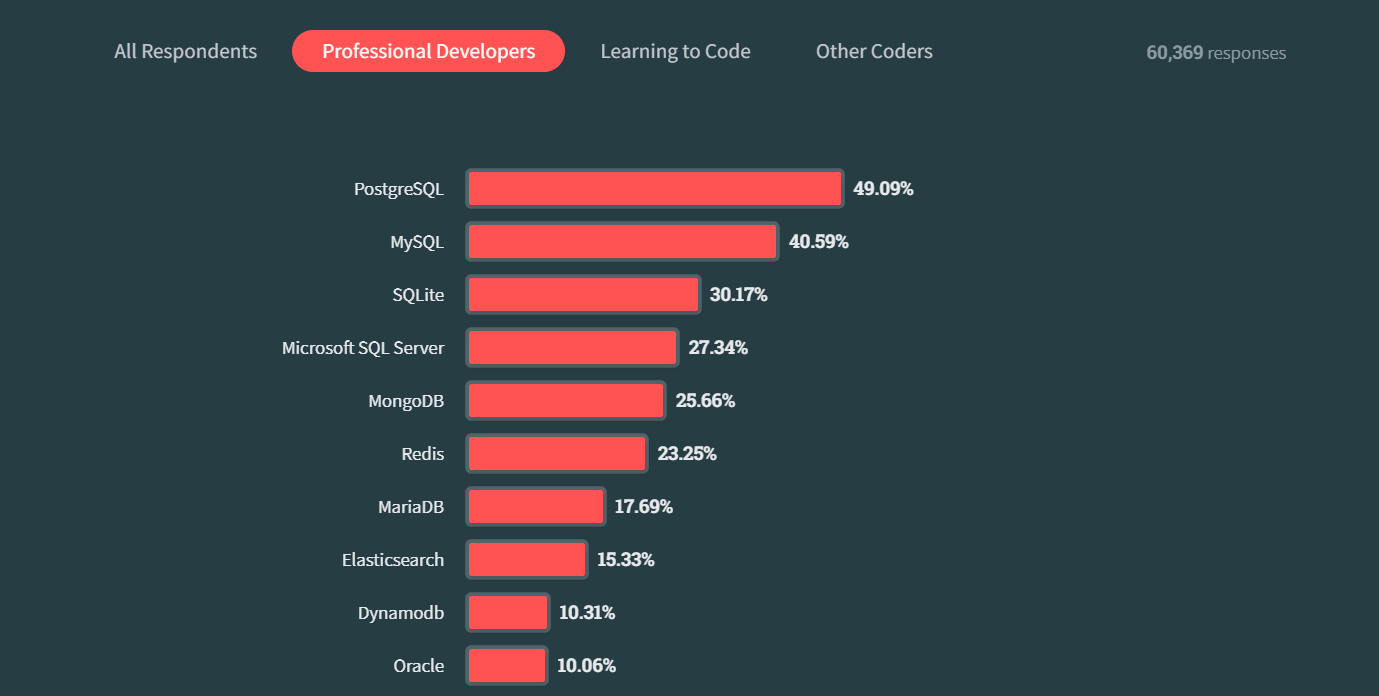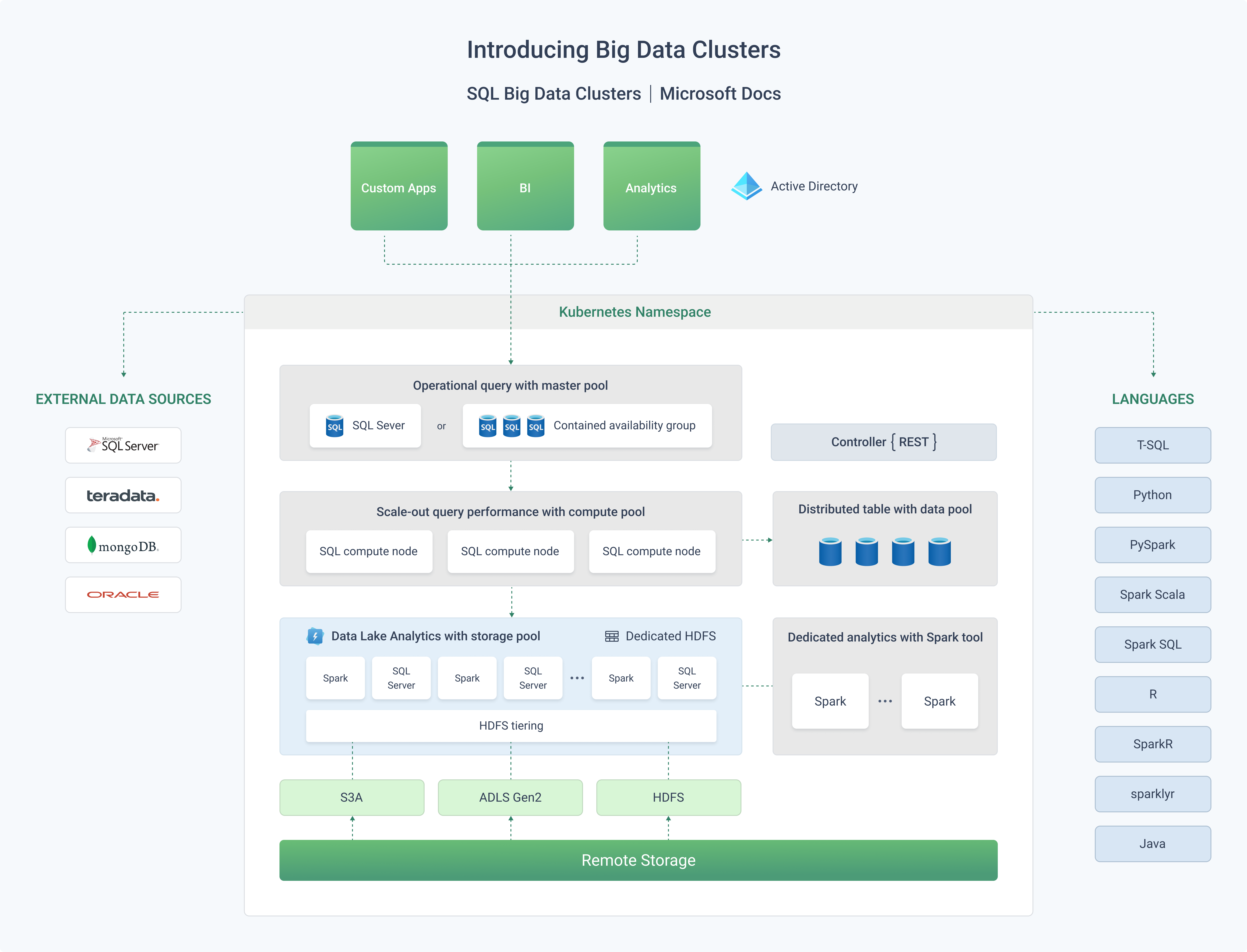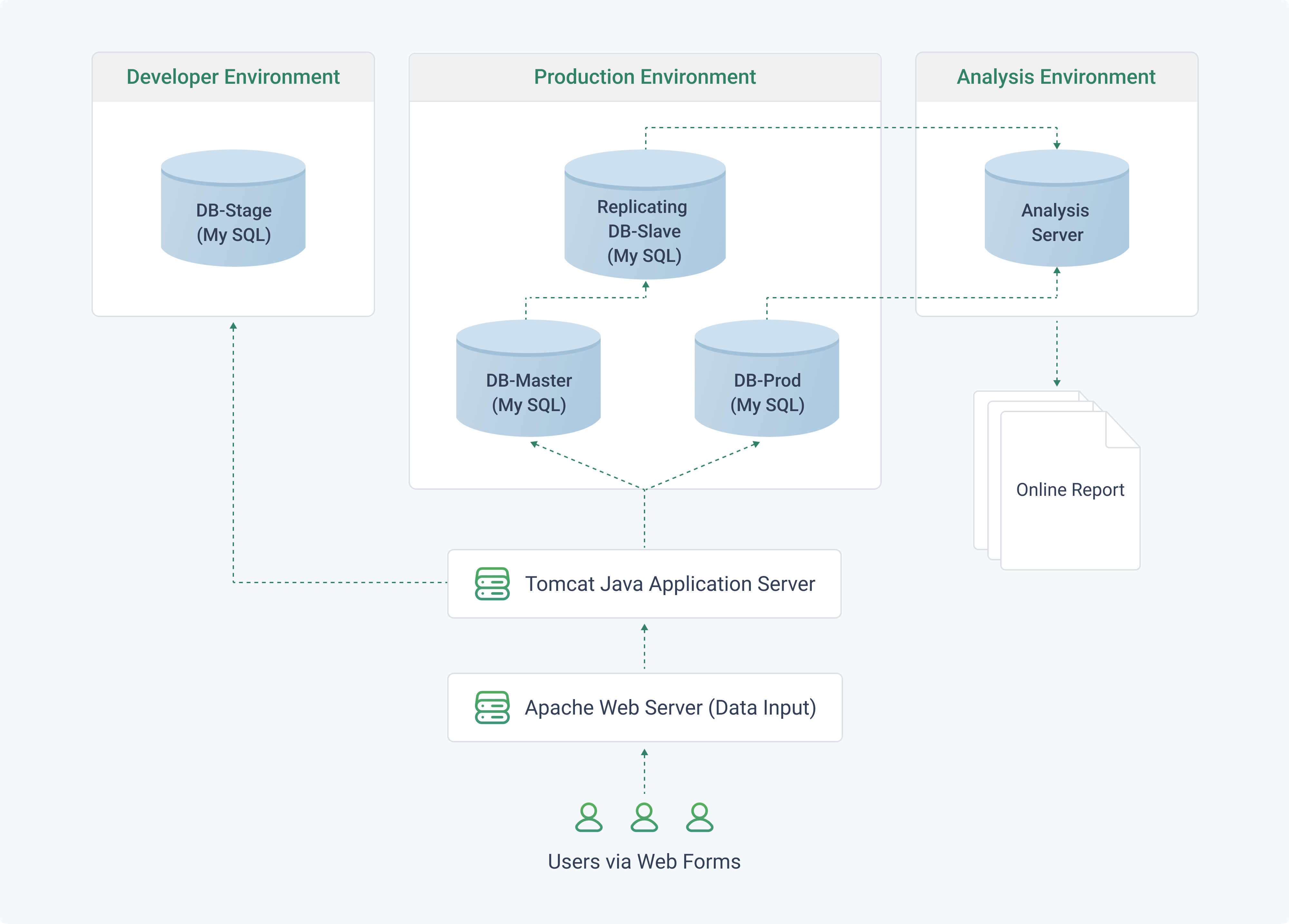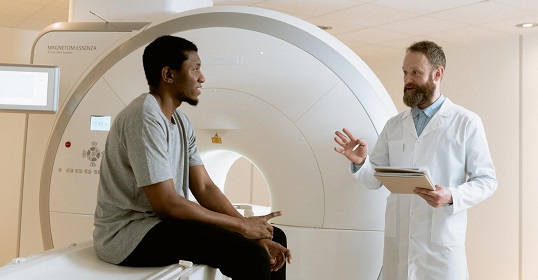Relational databases are historically the first databases, that's why they are so widely used in different industries including healthcare. The main goal of a relational database is to reduce data duplication. Relational databases store single pieces of information within tables, familiar to everybody today, using predefined relationships between them, like “this patient has this name/surname in the Patient Database Table and has this diagnosis from the Diagnosis Database Table”. Such databases are also known as SQL databases because SQL programming language is used to store, manipulate, and retrieve data from them. Talking about databases we can’t ignore infrastructure issues around databases, because they do not exist in a vacuum. In fact, healthcare businesses choose a database not on the fact of whether it’s relational or not but by taking into account hosting providers and their services.
Professional Developers mostly use relational databases like PostgreSQL, MySQL, SQLite, and Microsoft SQL Server. https://survey.stackoverflow.co/2022/#most-popular-technologies-database-prof
Databases in Healthcare: Zero Downtime and High Security
The healthcare industry, like a hospital, it's a 24/7 operation, it's open all year long. Hospitals have thousands of connections to the database and database administrators cannot afford to put the database down. If the database isn't available when a surgeon or doctor is in the operating room and needs to make a decision and they don’t have all the information about the patient anymore, that can have really big consequences.
There's a lot of private information in healthcare, and patients are involved. Looking at certain information, like an address or telephone number, should be locked for non-authorized users including… healthcare software developers. So developers must not have patient information in test and dev, they have to use not real but mixed data like names changed to something random, replacing characters, selecting a random record, and stuff like that.
Examples of Relational Databases in Healthcare
EHR Databases
eClinicalWorks sells electronic medical record and practice management software to more than 70,000 healthcare providers in the United States. Their Java-based applications use SQL Server databases.
They moved the database server to an Infrastructure as a Service (IaaS) cloud (Azure Virtual Machines and Azure Disk Storage). In a typical SQL cluster, the company has two VMs deployed in zone redundancy and one for disaster recovery in a different region to enhance availability and reliability. In total, they use 2,200 Azure virtual machines.
“Every customer gets their own back-end database and is logically separated on the shared infrastructure. This is how we’re able to deploy customers running independently without any commingling of data,” explains Bharat Satyanarayan, Vice President of Technology and Quality Assurance at eClinicalWorks.
Claims Databases
Consumer Direct Care Network (CDCN) provides different services to tens of thousands of individuals, including claim processing services.
They moved the back-end of their Claim Processing System from an on-premises to a Database as a Service (DBaaS) cloud (followed by rebuilding and rearchitecting to make it cloud-ready).
Using Azure SQL Database, a fully managed relational database service, CDCN can handle 400,000 transactions in billing and payroll a week, and their portal serves 200,000 users.
Health Analytics Databases
Health analytics company Dr Foster helps hospitals and regional care systems understand the factors influencing the quality of care, using Microsoft SQL Server Big Data Clusters.
“We need to be able to access like several hundreds of terabytes of data and that's data for every hospital in England. We need to be able to access it quickly and shape it and make sense of it. SQL allows us to do that with speed and with accuracy and helps us keep it safe,” says George Bayliffe, Head of Data at Dr Foster.
Five different teams work with the data store.
- Data engineering team manages data processes to pass usable data to the team of statistical analysts.
- Team of statistical analysts models the data with AI and machine learning to produce insights.
- Application development team builds web apps to present the data to customers.
- Consultant group provides custom services (including reporting) to customers.
- Operations team is responsible for the security, integrity, and availability of the data across the organization.
“[For one of our clients] we had to deploy our solution to a datacenter in Germany. By replicating the entire environment with Azure Virtual Machines, we can keep this data completely isolated from our network [to maintain data within national borders to satisfy GDPR regulations],” says George Bayliffe.
Database for Real-time Analytics in Healthcare
POCT Science House is a diagnostics company that enables healthcare providers to receive lab reports. It operates 85 labs that produce several thousand patient reports every day for district and community hospitals. Inside the labs, more than 400 automated analyzers identify chemicals and other characteristics in biological samples.
The data from the tests are then compiled into reports to help clinicians quickly identify signs of disease and propose treatments. Plus, the government uses anonymized versions of the data to get a broad view of the nation’s well-being to help plan healthcare policies.
The company uses Oracle MySQL HeatWave Database (managed database service) on Oracle Cloud Infrastructure to collect data from 400-plus automated analyzers. The integrated HeatWave in-memory query accelerator makes fats dashboard reporting without needing to move the data for analysis.
The medical device manufacturer Bionime provides diabetes patients with a self-monitoring blood glucose system.
Bionime selected Oracle MySQL HeatWave on AWS as a fully managed database service that combines transaction processing with an in-memory query accelerator for a high-performance analytics engine.
Oracle MySQL HeatWave consolidates both transaction processing and queries in one MySQL Database for real-time analytics. It eliminates the need for a separate analytics database and ETL (extract, transform, and load) processes.
Databases for Cloud-based Healthcare SaaS apps
Nuance Communications software technology corporation provides primarily SaaS-based speech recognition and transcription healthcare application that is used by more than 500,000 clinicians in 10,000 healthcare organizations globally to capture more than 300 million patient stories each year.
The company uses Azure SQL Database with the geo-replication features in two datacenters, so database changes are propagated in real-time from the master database to five read-only database instances across the datacenters to guarantee a recovery point objective (RPO) of five minutes or less.
IT Infrastructure of healthcare SaaS
- Azure Traffic Manager routes traffic to the closest data center based on network response times to provide the optimal user experience without any downtime.
- Azure Load Balancer routes the request to an available microservice instance deployed as an Azure Virtual Machine and can quickly be horizontally scaled to provide unlimited capacity. And while Azure Virtual Machines provide the raw compute power, Azure Storage is used to provide an access to the file system.
- Azure Virtual Network in conjunction with Network Security Groups is used to ensure that only authorized personnel has access to patient data.
- Azure Security Center to manage and monitor individual virtual machines for malware and virus protection.
Clinical Quality Registries
IT Infrastructure of Uppsala Clinical Research Center (UCR)
UCR's National Quality Registries include treatment and outcome data based on all hospital patients and are used by thousands of doctors, nurses, medical secretaries, and representatives within county councils.
A national quality registry contains person-based details relating to a problem, the taken actions, and the results within the health and care services. The registers provide feedback on the work of the healthcare providers and can generate intra-departmental comparisons of the treatments and results, as well as comparisons with other care providers.
We are "automatically loading patients' data, both from the primary health and hospital care, into the MySQL database servers," says Kalle Spångberg, Group Director at UCR.
The National Quality Registries is based on four MySQL servers. All in all, treatment data from about 1.5 million patients are registered in the Quality Registries.
The users of the National Quality Registries record patients, treatments and outcomes. It collects transferred patients' data automatically or through the online Web form.
The data is received by an Apache Web server which, in turn, sends a request to a Tomcat Java Application Server where logic and communication with the MySQL databases are managed. About 20 quality registries are allocated on two MySQL servers, "DBMaster" and "DB-Prod". Every night, the MySQL production database as well as the MySQL redundant slave database sends a batch of data to the analysis server, which produces dynamic reports through the National Quality Registries' online application.
Rate this article
Recommended posts
Portfolio
Our Clients' Feedback





















.jpg)
.jpg)
.jpg)
.jpg)
.jpg)
.jpg)
.jpg)
.jpg)
.jpg)
.jpg)
.jpg)
.jpg)
.jpg)
.jpg)
.jpg)
.jpg)
.jpg)
.jpg)
.jpg)
.jpg)
.jpg)
.jpg)
.jpg)
.jpg)
.jpg)
.jpg)
.jpg)
.jpg)
.jpg)
.jpg)
.jpg)
.jpg)
.jpg)
.jpg)
.jpg)
.jpg)
.png)
.jpg)
.jpg)
.jpg)
.jpg)
.jpg)
.jpg)
.jpg)
.jpg)
.jpg)
.jpg)
.jpg)
.jpg)
.jpg)
.jpg)
.jpg)
.jpg)
.jpg)
.png)
.jpg)

















We have been working for over 10 years and they have become our long-term technology partner. Any software development, programming, or design needs we have had, Belitsoft company has always been able to handle this for us.
Founder from ZensAI (Microsoft)/ formerly Elearningforce